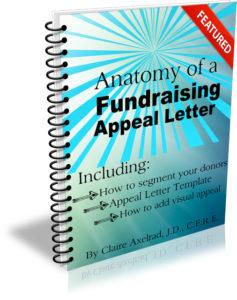Who writes your annual appeal letter? If it’s your executive director or your board chair there’s a very good chance it’s filled with jargon. This (pardon my non-jargon language) sucks.
Jargon is the opposite of constituent-centered writing.
It’s not your writer’s fault. Most of us use jargon all the time without being aware we’re doing so. It’s the language we speak when we work together in groups. It’s a sort of short-hand. Acronyms. Labels. Terms of art. It pops up all over the place. But, again, when it comes to using it in your fundraising appeals it’s bad news. Yet it’s exceedingly difficult to avoid. Why?
Jargon is insidious.
Originally, the word applied to trade languages used by people who spoke different native tongues to communicate. Jargon was esoteric, yet it was precisely defined for ease of communication between specialists in a given field (e.g., physics; mathematics; astronomy; computers; medicine; law). This made sense.
But guess what? When you write to your would-be supporters you’re not writing to your staff or ‘insiders.’ So as much as having these language short-cuts for ‘inside use’ makes sense, it’s also common sense that you’d want to avoid using technical language when trying to communicate with (or raise funds from) non-technically savvy ‘outsiders.’ Seems easy enough, no? But avoiding jargon is more tricky because it’s much more than scientific, technical lingo.
The type of jargon most used today is best described as a buzzword.
Such usage often develops from the appropriation of technical jargon, yet is used in a more general way, often inaccurately or inappropriately. It may be used due to an intentional desire to be vague or, perhaps, to a desire to impress. The key is that the words are used outside of the context where they’ll be easily grasped. [click here for a list of common business buzzwords; here for a list of nonprofit buzzwords from trend watcher Lucy Bernholz and here for a nifty Philanthropy Jargon Generator.] It quickly becomes clear that when you use jargon – and it’s worse when you string jargon words together – you leave a lot of folks scratching their heads.
If head scratching is the emotional call-to-action you’re going for, then be my guest. If not, then it’s good to be aware of where you may get into trouble.
6 TYPES OF MODERN JARGON TO AVOID IN YOUR FUNDRAISING APPEAL:
- A “clinical” or “official” or “specialist” word. In the nonprofit world this would extend to words like ‘case management’ (really, who wants to be either a ‘case’ or be ‘managed’?); ‘client’ (this is a broad categorization, even a dehumanization, of a real person who’s a child, parent or grandparent), or ‘youth’ (when is the last time you said “I’m going to pick the youths up at soccer?”). Jargon can simply be words that are used in white papers and grant proposals, but not in conversation (or fundraising appeals).
- A term of art. It may seem to be a perfectly ‘normal’, everyday word to you. But would your best friend really understand what it means? Another way to think about this is whether the terminology is especially defined in relationship to a specific activity, profession, group, or event. One example is ‘planned giving’ (even those within the profession disagree as to the meaning); others are ‘stakeholder’, ‘dashboard’ and ‘outside-the-box.’ When a term is only widely recognized in your industry, and not easily comprehended by the general public, this is jargon.
- A word that’s seldom part of every day usage. George Orwell wrote in Politics and the English Language: “Never use a foreign phrase, a scientific word, or a jargon word if you can think of an everyday English equivalent.” What does “microfinance” or “social entrepreneur” mean to the average person on your mailing list? I recently used the word “bandwidth” in a blog post, and not everyone understood what I meant. Test words out on colleagues if you aren’t sure.
- A pompous, “big” word. The original “Mad Man” advertising guru David Ogilvy, in an internal memo to Ogilvy & Mather employees in 1982, told his staff never to use jargon words like reconceptualize, demassification, attitudinally or judgmentally. A whole new definition, corporate jargon, is described as using sometimes-unwieldy elaborations of common English phrases, acting to conceal the real meaning of what is being said. Ogilvy defined jargon words as “hallmarks of a pretentious ass”.
- An acronym. Anything using letters can be an acronym. It’s not just reserved for scientific terms or names of organizations. It can be something as simple as “E.D.” or “CFRE” or “FTE” or “FY” or “ROI” or “YTD” (and these are acronyms used all the time by nonprofits in their literature). Acronyms will often stop a reader dead in their tracks if they’re not universally understood.
- An over-used phrase. When phrases pertain so universally as to become essentially meaningless, this is a form of jargon. (The same principle applies to “buzzwords”; while these are not offensive to everyone, you should be aware that some people go ballistic at their very mention). Examples of over use in the nonprofit world include: “these are trying economic times”; “making a difference”; “tradition of caring”, “underserved populations” and “changing the world.” Even words like “programs” and “services” have become meaningless jargon. If you don’t believe this can be less than effective, check out this post from the Non-Profit Humour blog (it’s seriously hilarious, and makes its point).
Jargon is bad because it deters understanding and slows your reader’s progress.
Jargon can make it take longer for folks to appreciate what you’re trying to say. This is bad because your readers are strapped for time! Not everyone will stop to do research in order to comprehend your intended meaning. Most, in fact, will simply give up. Others may pretend to understand; then they won’t act because they really had no clear idea what you were talking about. And all your efforts will have gone to waste.
Jargon is bad because it will fail to differentiate you from your competition.
You can’t stand out by using jargon, buzzwords and pablum. Jargon won’t help search engines find you either. How many others are trying to ‘change the world’? I’ll tell you: Google says 2,490,000,000. Remember: you have a mission and product or service you’re trying to convey as unique. Otherwise, why should any reader support you over another charity?
Comb your prose for jargon before you publish anything.
- If folks won’t understand it, dump it.
- If it sounds stuffy, pretentious or stilted, dump it.
- If there’s anything in it that only people in your industry would fully appreciate or understand, dump it.
- If what you’re saying could apply to a hundred other charities and is not uniquely you, dump it.
Don’t use any word that makes the reader want to ask: “What do you mean by that?” Let’s close with a tip from marketing guru David Ogilvy:
“Never send a letter or a memo on the day you write it. Read it aloud the next morning — and then edit it.”
Want more powerful tips to help this year’s annual appeal?
 Grab my Anatomy of a Fundraising Appeal Letter plus Sample Template. This is a simple, yet incredibly thorough, 62-page step-by-step guide to crafting a killer appeal letter or email appeal. If you’re ignoring any of the elements that go into making your appeal effective you’re ignoring your organization’s future.
Grab my Anatomy of a Fundraising Appeal Letter plus Sample Template. This is a simple, yet incredibly thorough, 62-page step-by-step guide to crafting a killer appeal letter or email appeal. If you’re ignoring any of the elements that go into making your appeal effective you’re ignoring your organization’s future.
As with all Clairification products this comes with a 30-day, no-questions-asked, 100% refund guarantee.
Image courtesy of Freedigitalphotos.net
-
Pingback: Avoid jargon in nonprofit communication | DonorDirect
-
Pingback: 6 Ways to Improve Your Annual Fundraising Appeal - NonProfit PRO
-
Pingback: Avoid jargon in nonprofit communication - DonorDirect
-
Pingback: Beware these pitfalls if you want to raise more money






